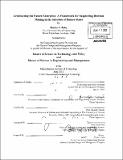| dc.contributor.advisor | Deborah Nightingale and Ricardo Valerdi. | en_US |
| dc.contributor.author | Raby, Matias A. (Matias Andres) | en_US |
| dc.contributor.other | System Design and Management Program. | en_US |
| dc.date.accessioned | 2012-09-14T17:16:00Z | |
| dc.date.available | 2012-09-14T17:16:00Z | |
| dc.date.copyright | 2012 | en_US |
| dc.date.issued | 2012 | en_US |
| dc.identifier.uri | http://hdl.handle.net/1721.1/72970 | |
| dc.description | Thesis (S.M. in Technology and Policy)--Massachusetts Institute of Technology, Engineering Systems Division, Technology and Policy Program; and, (S.M. in Engineering and Management)--Massachusetts Institute of Technology, Engineering Systems Division, System Design and Management Program, 2012. | en_US |
| dc.description | Cataloged from PDF version of thesis. | en_US |
| dc.description | Includes bibliographical references (p. 103-106). | en_US |
| dc.description.abstract | Enterprises that are successful over the long term are compelled to continuously transform in order to adapt to new contexts or economic environments. However, many of these transformation efforts fail to achieve their desired objectives. MIT Professors Nightingale and Rhodes have been developing an integrative approach that uses Enterprise Architecting as an instrument to support the planning of successful transformation. Although the approach has shown to be useful to guide transformations in various domains, feedback from previous users indicated the need for a more prescriptive and quantitative guidance in the process of moving an enterprise from the 'As-Is' to the desired 'To-Be' state. This thesis introduces a framework that provides a structure of reasoning about the process of architecting the future state of an enterprise in the context of a transformation. The 'Architecting the Future Enterprise' (AFE) Framework is an iterative method that incorporates a systems thinking approach to design future states and a multidimensional evaluation process that compares competing architectures in terms of effectiveness, effort and risk. It enables the generation of an output in the form of an Architecture Tradeoffs Matrix, a quantitative visual representation to assess tradeoffs among competing architectures. A case study is included to illustrate a real application of the AFE Framework. The implications of this research span across two areas. First, it aims to formalize enterprise transformation planning policies by providing practitioners a structure for reasoning that can help to minimize decision making errors. Second, by introducing quantification approaches to effectiveness, effort and risk, it improves the decision making process normally followed by enterprise leaders and architects to select the future architecture of their organizations. Finally, the framework leverages the use of simple engineering and management tools that lead to more informed decisions and to practical contributions to the practice of enterprise architecting and management decision making. | en_US |
| dc.description.statementofresponsibility | by Matias A. Raby. | en_US |
| dc.format.extent | 115 p. | en_US |
| dc.language.iso | eng | en_US |
| dc.publisher | Massachusetts Institute of Technology | en_US |
| dc.rights | M.I.T. theses are protected by
copyright. They may be viewed from this source for any purpose, but
reproduction or distribution in any format is prohibited without written
permission. See provided URL for inquiries about permission. | en_US |
| dc.rights.uri | http://dspace.mit.edu/handle/1721.1/7582 | en_US |
| dc.subject | Engineering Systems Division. | en_US |
| dc.subject | Technology and Policy Program. | en_US |
| dc.subject | System Design and Management Program. | en_US |
| dc.title | Architecting the Future Enterprise : a framework for supporting decision making in the selection of future states | en_US |
| dc.title.alternative | Framework for supporting decision making in the selection of future states | en_US |
| dc.type | Thesis | en_US |
| dc.description.degree | S.M.in Engineering and Management | en_US |
| dc.description.degree | S.M.in Technology and Policy | en_US |
| dc.contributor.department | System Design and Management Program. | en_US |
| dc.contributor.department | Massachusetts Institute of Technology. Engineering Systems Division | |
| dc.contributor.department | Technology and Policy Program | |
| dc.identifier.oclc | 808490355 | en_US |
